Home University of Edinburgh Library Essentials
July 27, 2024
Women in STEM studies and careers: Professor Beth Biller and Dr Mary Brück at the University of Edinburgh
Posted on December 1, 2023 | in Uncategorized | by lbeattieAsh Mowat is one of our volunteers in the Civic Engagement Team. Ash has been looking into the career paths of two women in science: Professor Beth Biller, currently Professor at the Institute for Astronomy, part of the School of Physics and Astronomy at the University of Edinburgh, and Dr Mary Brück, previously a principal scientific officer at the Royal Observatory Edinburgh.
The aim of this blog is to explore the work of two women astronomers with links to the University of Edinburgh. Firstly Professor Beth Biller, currently in post at the Royal Observatory, and also an earlier pioneer Dr Mary Brück who was first a postgraduate student and later teacher here from the 1940s onwards. In doing so we’ll explore the historic and current levels of obstacles facing women accessing studies and careers within the STEM (science, technology, engineering and mathematics) fields.
Introducing Professor Beth Biller

(Image above courtesy of footnote 1 below)
Professor Beth Biller is a Professor, previously Chancellor’s Fellow, at the Institute for Astronomy, part of the School of Physics and Astronomy at the University of Edinburgh. According to her biography on the university’s website, her research interests centres around direct imaging detection and characterization of extrasolar planets and brown dwarfs.[1]
Professor Biller was part of the research team on the recent observations from the James Webb telescope surrounding the atmospheric features elements detected on Planet VHS 1256b, some 40 light years away from earth.[2] Professor Biller commented “There’s a huge return on a very modest amount of telescope time. With only a few hours of observations, we have what feels like unending potential for additional discoveries”.
These exciting early findings were also further covered on the BBC and elsewhere.[3] Further information on the James Webb telescope can be found here. [4]
Professor Biller kindly consented to answer a few questions to give a fascinating insight into her early childhood interest in the planets and journey from education into her current work and areas of interest.
Q1: Can you recall from childhood when you first experienced an enthusiasm for any STEM subject and what these were?
Oh, very early on for me — I was fascinated by the planets in our solar system when I was 5 or 6 years old, especially the fact that Venus has thick cloud cover with sulphuric acid rain!
Q2: During your school education were you aware of differing expectations placed on boys and girls in terms of their being encouraged to choose STEM subjects and of their actual or predicted academic achievements in these?
I wasn’t consciously aware of differing expectations, but I do think such expectations affected what academic subjects I was encouraged to pursue. I was good, but not spectacular at maths, but quite strong in humanities subjects. I found that I received more encouragement for pursuing a humanities degree than a science degree, since I wasn’t an obvious “math whiz”.
Q3: When were you first drawn to astronomy, what sparked it, and how long did it take for you to decide to study this at University?
I was very interested in astronomy as a small child, then in school found myself channelled more into the humanities (for the reasons described above). When I was in high school, the first extrasolar planets were detected — and I pretty much decided at that point that astronomy was what I wanted to study, even if I wasn’t “good at maths”. However, what I’ve discovered since then is that mathematics, like so many other things, is a learned skill — and practice makes perfect.
Q4: What was your experience like at University both in terms of the course structure and teaching, and the general experience as a student?
I had a very different student experience compared to students at large Universities like the University of Edinburgh.
I went to a “small liberal arts college” in the United State, which is a type of institution that simply doesn’t exist in the UK — a very small undergraduate degree-granting institution with only 1600 students. My initial degree was in Astrophysics. An undergraduate degree in any strand of physics is intense. To be honest, pursuing my undergraduate degree was more intense and stressful than my PhD or working in the field has been.
Q5: Can you please tell us a little about your areas of specialisation in your astronomy work currently, and why they are so compelling?
I work on direct imaging of exoplanets, in other words, removing starlight to be able to produce images of planets hiding in the glare of their stars. Right now, this technique is only possible for young, high-mass planets e.g. analogues to Jupiter, but caught right after they have formed, so they are a lot hotter and brighter than Jupiter. The planets I study right now have cloud-top temperatures of ~1000 K, similar to a candle flame, and clouds made up of very fine particles of silicates. This means these are very not-habitable planets. However, all the techniques we are developing now can be applied to image rocky habitable zone planets around stars similar to our own Sun in future decades. Direct imaging is the likely method by which we will discover the first true Exo-Earth twin — i.e. a 1 MEarth planet orbiting at 1 astronomical unit from a star with a similar mass as our Sun.
Q6: What has been your experience of the James Webb telescope and its future potential, and is there still valuable exploring to be done with others such as the very large telescope? Also what will new developments like the extremely large telescope add to what the James Webb is providing?
JWST is amazing! It is performing extremely well and it looks like it may have a 20+ year lifetime. I’ve been very lucky to be the co-PI of one of the JWST Early Release Science Programs. We’ve obtained coronagraphic imaging of a young exoplanet, spectra of a somewhat more widely separated planetary mass object, and coronagraphic imaging of a young, planet forming disk. All of the data have been absolutely superb, and in the spectroscopic data we are finding a veritable zoo of new spectral features that we have not been able to study previously from the ground. The upcoming extremely large telescopes will be very complementary to JWST — JWST lets us observe at wavelengths inaccessible from the ground (>5 um), while the ELTs will provide improved resolution and contrast, producing the first direct imaging detections of older and colder planets more similar to the planets in our own solar system.
Q7: What advice would you give to a child or young adult with a passion for astronomy who wants to learn more and improve their potential to study at university level?
Make sure to take maths and sciences Highers — and remember, mathematics, coding, and analytical skills are all things that can be learned through practice.
Q8: If you received an unlimited NASA or other budget to use, what would be your dream mission project to explore and why?
Oh, that would definitely be a successor telescope to JWST, with the potential to image and characterize Earth-like habitable planets!
Whilst the equal representation of women in STEM subjects is far from being realized, Dr Biller’s and many others examples are an encouraging indication of a positive momentum for change. The following recent BBC features describes substantive increases in the numbers of women entering STEM careers. [5] Furthermore the recent appointment of Dr Nicola Fox as Associate administrator for NASA’s Science Mission Directorate (the organisations head of science, and only the second woman to have held this role) demonstrates that the highest positions could and should be equally obtainable by anyone with the experience and expertise, regardless of gender.[6]
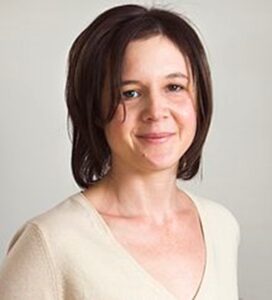
(Image of Dr Cordelia Fine above courtesy of footnote 7 below)
Dr Cordelia Fine[7], the Canadian author and philosopher of science and psychologist, has written several absorbing and brilliantly researched texts serve to dispel the myths of distinct male and female brains and exposes how restrictive gender constructs in how children are raised and not biology help precipitate reduced opportunities for women in STEM careers, and equally for men in more nurturing roles like primary school teaching. Dr Fine lived and schooled in Edinburgh before studying at Oxford and Cambridge, and won the Edinburgh Medal in 2018 for her work, and additionally won the Royal Society Science Book prize in 2017 for her book Testosterone Rex which includes the following: “Beyond the genitals sex is surprisingly dynamic, and not just open to influence from gender constructions, but reliant on them. There are no essential male or female characteristics”.
Dr Mary Brück Biography and University Archive materials
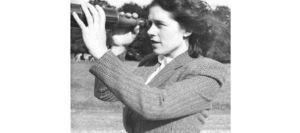
(Image above courtesy of footnote 8 below)
Dr Brück (nee Conway 1925-2008) was born in Ireland and became a STEM pioneer studying and later teaching in the fields of astronomy and astrophysics at the University of Edinburgh.[8] The Mary Brück building at the University of Edinburgh Kings Buildings campus was built in recognition of her academic achievements, research, findings and teachings, and as an empowering role model demonstrating the capabilities of women in subjects traditionally deemed only suitable for men. That she was active in delivering lectures and inspiring others well into her retirement and until near her death, is further evidence of her energy, resilience and highly valued expertise.
As well as becoming a senior lecturer Dr Brück continued research and published her findings academically, specialising in the area of stars, the interstellar medium and Magellanic Clouds. [9] She received the Lorimer Medal from the astronomical society of Edinburgh in 2001 for her extensive contribution in making the subject of astronomy accessible to and of interest to the widest audience, not solely to those in academia. She was further awarded a fellowship of Edinburgh University in 2005 at the age of eighty.
I was privileged to been granted access to some of her archive papers (as yet not catalogued) held at the University of Edinburgh Astronomy department on Blackford Hill. [10]

(Image of Dr Brück and colleagues at the Royal Observatory; she is seated in the front row fourth from the left).
It emerges very evidently from looking through her documents that Dr Brück was something of a polymath, with wider interests in sciences and mathematics, the visual arts, history, poetry etc. It seems clear that her lifelong academic passion was for astronomy, both in studying and teaching to bring her joy for the field onto others.
She devoted a lot of research and writing on the current and historic role of women in history, and early pioneer of women in STEM studies and careers.
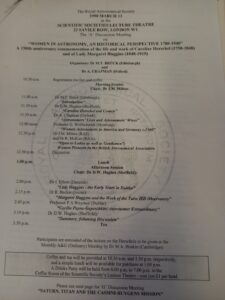
The above Women in Astronomy Perspective event was both organised and introduced by Dr Brück. This is remarkable evidence of her energy and commitment in her chosen science well into her retirement, as she was into her seventies and continuing research, writing, events and public speaking.
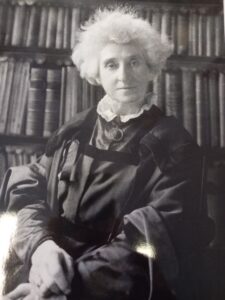
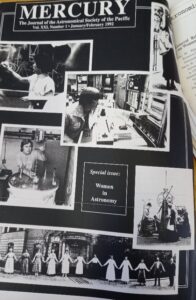
(Image on the above left of earlier woman astronomer pioneer Lady Margaret Huggins[11] whom Dr Brück extensively researched and wrote upon to promote her achievements and legacy. Image on the right of an issue of Mercury magazine cover with a special focus on women in astronomy).
In her records there is much evidence of Dr Brück’s Christian faith and how she strove to dispel the lazy myth that there is any discrepancy or conflict between being both a practitioner of science and having religious faith and convictions.
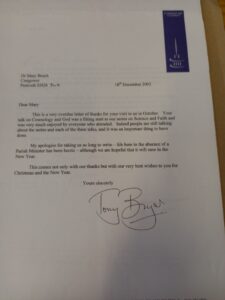
(The above letter refers to Dr Brück’s ongoing work on speaking to address the links between God and science).
A further interesting exchange on religion and science is revealed in the article below on the left, and Dr Brück’s letter of response. The article was a Times newspaper critique of the Pope John Paul 11. Dr Brück responded to rebuke the antiquated reference to Galileo and historic disputes between science and religion that she argues have since been bridged with better shared understandings. It is perhaps notable that she elects not to respond to the journalist’s comments on the Catholic Church’s attitudes on homosexuality, contraception and the scope for women to enter the priesthood, although her main focus of her short response was to emphasise her assertions on the coexistence of practicing scientific endeavours and a religious faith.
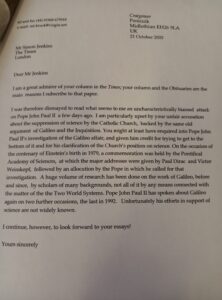
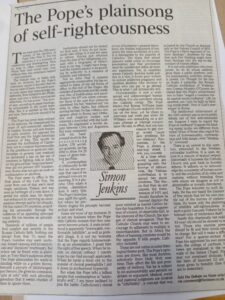
A fascinating find amidst her records is a handwritten series of 8 lectures on astrophysics that Dr Brück both wrote and presented to students. It includes such topics as methods of observation (the different types and sizes of telescopes and their uses and capacities), the properties and types of stars (mass, luminosity, temperatures etc.), interstellar matter and the relationships between bodies in our solar system and beyond.
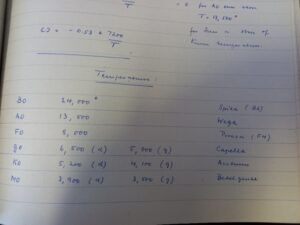
(Image from lecture notes above on comparative star types and temperatures).
From the introduction to the series of lectures she writes:
“In the following series of lectures I shall attempt to introduce you to the subject of astrophysics which, I believe, represents one of the most active and promising fields of present day scientific research. Astrophysics is a very young subject. However it has grown so much already and it is growing so rapidly that all I can say here is to give you a genuine summary of the main procedures under discussion, of the methods of investigation, and of the results obtained so far.”
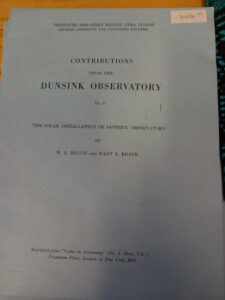

(Cover and image above from joint publication of Dr H.A and Dr Mary Brück)
In conclusion, it is abundantly evidenced in these archives that Dr Mary Brück was a formidable pioneer of women in science, and in her field of astronomy a passionate expert who sought to promote and teach the science to others, and who consistently strove to have recognised and valued the legacy of earlier women astronomers that preceded her. She tirelessly devoted a lifetime to her chosen academic field, continuing to pursue valuable research and lecturing roles well into her seventies and eighties. She should rightfully be celebrated as a major force in her academic achievements and teachings, and an early role model and inspiration to others for the opportunities and representations of women in STEM studies and careers.
Finally I should like to thank Professor Biller for finding the time to answer some questions on her areas of interest and expertise, with thanks also to staff at the University of Edinburgh Royal Observatory for kindly allowing access to view records from the Mary Brück archives.
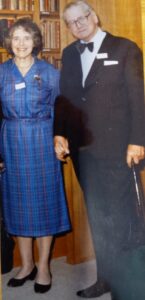
(The two fellow Dr Astronomers: Dr Mary Brück and her husband Dr Hermann Brück)
[1] https://www.ph.ed.ac.uk/people/beth-biller
[2] https://www.ph.ed.ac.uk/news/2023/distant-planets-features-revealed-by-webb-telescope-23-03-22
[3] https://www.bbc.co.uk/news/science-environment-65040983
[5] The women who left their jobs to code – BBC News
[8] https://www.ed.ac.uk/equality-diversity/celebrating-diversity/inspiring-women/women-in-history/mary-bruck
Collections
 Archival Provenance Project: Emily’s finds
My name is Emily, and I’m the second of the two archive interns that...
Archival Provenance Project: Emily’s finds
My name is Emily, and I’m the second of the two archive interns that...
 Archival Provenance Project: a glimpse into the university’s history through some of its oldest manuscripts
My name is Madeleine Reynolds, a fourth year PhD candidate in History of Art....
Archival Provenance Project: a glimpse into the university’s history through some of its oldest manuscripts
My name is Madeleine Reynolds, a fourth year PhD candidate in History of Art....
Projects
 Sustainable Exhibition Making: Recyclable Book Cradles
In this post, our Technician, Robyn Rogers, discusses the recyclable book cradles she has developed...
Sustainable Exhibition Making: Recyclable Book Cradles
In this post, our Technician, Robyn Rogers, discusses the recyclable book cradles she has developed...
 Giving Decorated Paper a Home … Rehousing Books and Paper Bindings
In the first post of this two part series, our Collection Care Technician, Robyn Rogers,...
Giving Decorated Paper a Home … Rehousing Books and Paper Bindings
In the first post of this two part series, our Collection Care Technician, Robyn Rogers,...
